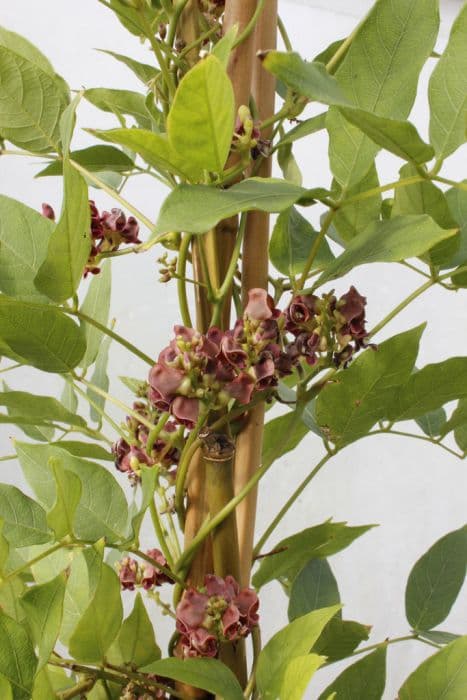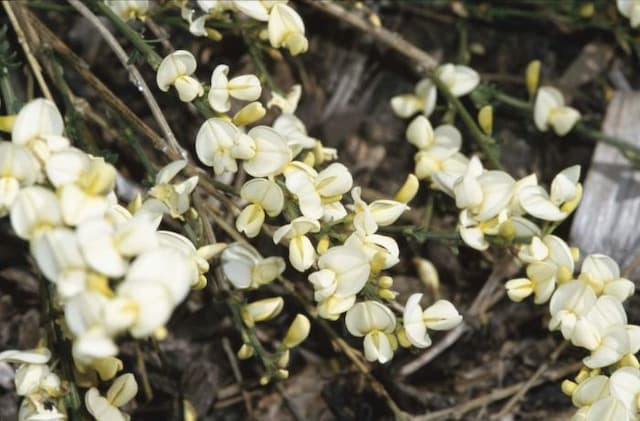Sweet pea Lathyrus odoratus 'Winston Churchill'
ABOUT
The sweet pea known as 'Winston Churchill' is a captivating flowering plant admired for its vibrant blossoms and delightful fragrance. It boasts large, ruffled flowers that come in a deep crimson or sometimes reddish-purple hue, often attracting attention in the garden for their striking coloration. Each flower is characterized by its classic sweet pea shape with a broad standard petal at the back and smaller wing petals on the sides, creating an elegant and charming display. The blooms of 'Winston Churchill' sweet pea are particularly noted for their intense, sweet scent, which can perfume the air around them, making them a favorite in cut flower arrangements where their aroma can be enjoyed indoors. The foliage consists of medium-green, pinnate leaves made up of multiple leaflets, which add a soft, textured backdrop to the vivid flowers. The stems are ideal for climbing, and they often require support from trellises or other structures to showcase the plant's full beauty as it produces tendrils that help it grip and ascend. As with other varieties of sweet peas, the 'Winston Churchill' flourishes in cooler climates and tends to bloom profusely in the spring and early summer, making it a popular choice for gardeners looking to add a touch of drama and fragrance to their outdoor spaces. It adds a classic aesthetic with its rich coloring and is a symbol of early 20th-century garden elegance.
About this plant
 Names
NamesFamily
Fabaceae.
Synonyms
Sweet Pea, Spencer Sweet Pea.
Common names
Lathyrus odoratus.
 Toxicity
ToxicityTo humans
The plant commonly known as sweet pea can be toxic if ingested in large quantities. The seeds and other plant parts contain a compound called aminoproprionitrile, which can lead to a condition known as lathyrism if consumed in large amounts. Lathyrism is characterized by symptoms such as weakness and paralysis of the lower limbs, and in severe cases, it can lead to permanent paralysis and muscle wasting. Consumption of the seeds particularly should be avoided to prevent potential toxicity.
To pets
Toxicity in the sweet pea to pets, including dogs and cats, is similar to that in humans. Ingestion of the plant, especially the seeds, can lead to lathyrism. Symptoms of poisoning in pets may include vomiting, lethargy, convulsions, and if consumed in significant amounts, it may lead to paralysis and potentially permanent muscle damage. Avoid allowing pets to ingest any part of the plant to prevent these toxic effects.
 Characteristics
CharacteristicsLife cycle
Annuals
Foliage type
Deciduous
Color of leaves
Green
Flower color
Red
Height
6 feet (1.8 meters)
Spread
1 foot (0.3 meters)
Plant type
Climber
Hardiness zones
2
Native area
Mediterranean
Benefits
 General Benefits
General Benefits- Aesthetic Appeal: Lathyrus odoratus 'Winston Churchill', commonly known as sweet pea, produces vibrant, crimson flowers that enhance the visual appeal of gardens and landscapes.
- Fragrance: The flowers are known for their sweet, pleasant fragrance which can be enjoyed in the garden or as cut flowers indoors.
- Pollinator Attraction: Sweet peas attract beneficial insects such as bees and butterflies, promoting pollination in the garden.
- Vertical Interest: As a climbing plant, sweet peas can be grown up trellises and supports, adding vertical interest to garden designs.
- Easy to Grow: They are relatively easy to grow from seed, making them accessible to gardeners of varying experience levels.
- Seasonal Color: Sweet peas provide a burst of color in spring and early summer when many other plants are not in full bloom.
- Compatibility: They can be planted along with other plants without demanding excessive space or resources, making for harmonious garden companions.
- Versatility: Sweet peas are suitable for cut flower gardens, borders, pots, and containers, showing their adaptability to different garden settings.
- Edible: Although not directly a benefit of this ornamental variety, some parts of sweet peas have been traditionally used in cooking, especially in pea shoots salads.
 Medical Properties
Medical PropertiesThis plant is not used for medical purposes.
 Air-purifying Qualities
Air-purifying QualitiesThis plant is not specifically known for air purifying qualities.
 Other Uses
Other Uses- Art and Crafts: The sweet pea's vibrant flowers and appealing fragrance make it an excellent natural material for creating potpourri, dried flower arrangements, and botanical art pieces.
- Educational Tool: Sweet pea is often used in educational settings to teach students about plant biology, genetics (its role in the discovery of Mendelian inheritance), and horticulture practices.
- Social and Cultural Events: With its attractive flowers and scent, sweet pea is a popular choice for decorating venues for weddings, anniversaries, and other celebrations, adding a touch of natural elegance.
- Photography: Sweet pea, especially vibrant varieties like 'Winston Churchill,' is popular among photographers who use the blooms as subjects or backdrops in floral photography due to their rich colors.
- Companion Planting: Sweet pea can be used in the garden for companion planting to support and encourage the growth of other plants by fixing nitrogen in the soil.
- Perfumery: The fragrance of sweet pea flowers can be captured and used as a delicate scent note in homemade perfumes and scented oils.
- Culinary Garnish: Although the seeds and plants can be toxic if ingested in large quantities, the flowers can be used as an edible garnish for culinary presentations, as long as they haven't been treated with pesticides.
- Symbolism: Sweet pea carries various symbolic meanings, including blissful pleasure, goodbye, departure, and thank you for a lovely time, and is thus used in floral language communication.
- Writing and Ink Making: Historically, some plants have been used to make natural inks and dyes; sweet pea petals could be explored in this capacity for crafting homemade inks.
- Handmade Paper: The fibers and petals of sweet pea can be incorporated into the paper-making process to create decorative, eco-friendly handmade paper.
Interesting Facts
 Feng Shui
Feng ShuiSweet pea is not used in Feng Shui practice.
 Zodiac Sign Compitability
Zodiac Sign CompitabilitySweet pea is not used in astrology practice.
 Plant Symbolism
Plant Symbolism- Blissful Pleasure: The fragrant nature of sweet peas is often associated with the pleasure and joy they bring to the senses.
- Goodbye: Sweet peas can symbolize a farewell or departure, possibly because they have a short blooming season, thus representing transient goodbyes.
- Delicate Pleasures: Their delicate, frilly flowers and gentle scent are indicative of enjoying the subtle and delicate moments in life.
- Thankfulness: They are sometimes given to express gratitude for a lovely time or to acknowledge someone's company.
- Kind Departures: Sweet peas can indicate a kind and gentle leave-taking or goodbye that bears no hard feelings.
 Water
WaterSweet peas should be watered deeply and regularly, with frequency depending on the weather and soil moisture levels. Generally, for the 'Winston Churchill' variety, aiming for 1 inch of water per week is favorable, adjusting as necessary during hot or dry periods. It's best to water early in the morning to allow foliage to dry out during the day, reducing the risk for fungal diseases. Overhead watering should be avoided to keep the leaves dry; instead, use a soaker hose or drip irrigation at the base of the plant. During the peak of summer, you may need to water sweet peas every few days, ensuring that the soil is consistently moist but not waterlogged.
 Light
LightThe sweet pea 'Winston Churchill' thrives in full sun to partial shade, with the ideal location receiving at least 6 hours of sunlight daily. A spot that offers morning sunlight and some afternoon shade can help protect the plant from intense heat. Sweet peas prefer cooler temperatures, so if you're in a warmer climate, ensure that the plant receives shade during the hottest part of the day.
 Temperature
TemperatureSweet peas, including the 'Winston Churchill' variety, prefer temperate climates and grow best when daytime temperatures are between 55°F and 65°F. They can tolerate a minimum temperature of about 25°F but frost can damage the plant. Ideally, sweet peas should be grown in conditions that avoid prolonged exposure to temperatures above 80°F as high heat can stunt growth and flowering.
 Pruning
PruningSweet peas, including the 'Winston Churchill' variety, should be pruned to encourage bushy growth and more blooms. Pinch out the growing tip when plants are 4-6 inches tall. As flowers fade, regularly deadhead to promote continuous blooming throughout the season. The best time for major pruning would be late winter or early spring before new growth begins. Light pruning can be done throughout the growing season to maintain shape and vigor.
 Cleaning
CleaningAs needed
 Soil
SoilSweet peas favor rich, well-draining soil with a pH of 6.0 to 7.5. An ideal soil mix for Sweet Pea 'Winston Churchill' can be achieved by blending two parts garden soil, one part well-rotted compost or aged manure, and a handful of perlite or vermiculite to improve drainage. Ensure to mix the soil thoroughly before planting. Regular mulching can also help maintain soil moisture and temperature.
 Repotting
RepottingSweet Pea 'Winston Churchill' is typically grown as an annual, so repotting is not often required. If started indoors, they should be transplanted once into the garden when weather conditions are favorable. If grown in containers, consider using a larger pot every season when replanting to accommodate growth.
 Humidity & Misting
Humidity & MistingSweet Pea 'Winston Churchill' prefers moderate humidity levels, consistent with outdoor conditions in temperate climates. They are fairly adaptable but might struggle in very arid or excessively humid environments. It's best to aim for a humidity level that mimics a typical spring day, as the plants do not have specific high humidity requirements.
 Suitable locations
Suitable locationsIndoor
Place in a well-lit spot, support with trellis; keep soil moist.
Outdoor
Full sun, moist well-drained soil, support for climbing, mulch base.
Hardiness zone
2-11 USDA
 Life cycle
Life cycleSweet pea 'Winston Churchill' begins its life cycle when the seed is sown into well-drained soil, usually in late winter or early spring. The seed germinates, typically within 7 to 14 days, leading to the emergence of a small seedling with pairs of leaf-like structures called cotyledons. As it grows, the plant develops a climbing stem and compound leaves with tendrils that allow it to grasp onto supports. It enters a vegetative stage where it produces lush foliage before transitioning to the flowering stage in late spring or early summer, displaying its fragrant, colorful blossoms. After pollination, often by bees, the flowers develop into seed pods, and once mature, the seeds can be harvested for planting the following season. The plant is annual; it completes its life cycle within one year and then dies, leaving seeds as its legacy to start the cycle anew.
 Propogation
PropogationPropogation time
Spring
The Sweet Pea 'Winston Churchill' is typically propagated through seed sowing. The ideal time to sow sweet pea seeds is either in late fall or between January and April, as they require a period of cold to germinate successfully. The most popular method of propagation is direct sowing into the soil. To do this, soak the seeds for 24 hours in water to soften the hard outer shell, which makes it easier for the embryo inside to break through. After soaking, plant the seeds about 1 inch deep and 2 to 3 inches apart in well-drained soil in a sunny location. Cover the seeds lightly with soil and water them well. Within 10 to 28 days, and usually when the temperature is around 55-65 degrees Fahrenheit (13-18 degrees Celsius), the seeds should germinate, soon after which you can expect to see the trademark delicate tendrils of the 'Winston Churchill' Sweet Pea start to grow.









